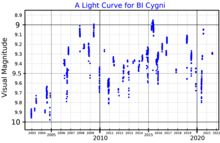BI Cygni
BI Cygni is the small very red dot right on the left edge of this image. The bright star at the centre is γ Cygni and north is to the right. Credit: Erik Larsen | |
| Observation data Epoch J2000 Equinox J2000 | |
|---|---|
| Constellation | Cygnus |
| Right ascension | 20h 21m 21.8869s[1] |
| Declination | 36° 55′ 55.729″[1] |
| Apparent magnitude (V) | 8.4 – 9.9[2] |
| Characteristics | |
| Evolutionary stage | Red supergiant |
| Spectral type | M4 Iab[2] |
| Variable type | Lc[2] |
| Astrometry | |
| Radial velocity (Rv) | −7.48±0.42[1] km/s |
| Proper motion (μ) | RA: −2.751[1] mas/yr Dec.: −5.459[1] mas/yr |
| Parallax (π) | 0.3541 ± 0.0377 mas[1] |
| Distance | 4,349+548 −440 ly (1,334+168 −135 pc)[3] |
| Absolute magnitude (MV) | −6.78[4] |
| Details | |
| Mass | 17[5] M☉ |
| Radius | 852+12 −9 – 908+12 −10[3] R☉ |
| Luminosity | 89,300[5] L☉ |
| Surface gravity (log g) | -0.35[6] cgs |
| Temperature | 3,575[3][5] K |
| Metallicity [Fe/H] | +0.40[6] dex |
| Age | >12[5] Myr |
| Other designations | |
| Database references | |
| SIMBAD | data |
BI Cygni (BI Cyg, IRC +40408, BD+36 4025) is a red supergiant in the constellation Cygnus. It is an irregular variable star with a maximum brightness of magnitude 8.4 and a minimum of magnitude 9.9. It is considered a member of the Cygnus OB1 stellar association,[4] its distance is around 1,300 parsecs (4,200 ly) of the Solar System. It is less than a degree south of another variable red supergiant, BC Cygni.

BI Cyg is a slow irregular variable star classified as type Lc, an irregular supergiant. Its brightness changes between extremes of magnitude 8.4 and 9.9.[2] Frequency analysis of its light curve shows no significant periods.[8]
BI Cyg is one of the largest known stars with a radius around 850 R☉, measured by its angular diameter by the CHARA array.[3] It is about 90,000 times more luminous that the Sun and has a cool effective temperature of 3,535 K.[5] Its mass is estimated at 17 solar masses, and it took 12 million years to enter the red supergiant phase.[5]
See also
[edit]Notes
[edit]References
[edit]- ^ a b c d e f Vallenari, A.; et al. (Gaia collaboration) (2023). "Gaia Data Release 3. Summary of the content and survey properties". Astronomy and Astrophysics. 674: A1. arXiv:2208.00211. Bibcode:2023A&A...674A...1G. doi:10.1051/0004-6361/202243940. S2CID 244398875. Gaia DR3 record for this source at VizieR.
- ^ a b c d Samus, N. N.; Durlevich, O. V.; et al. (2009). "VizieR Online Data Catalog: General Catalogue of Variable Stars (Samus+ 2007-2013)". VizieR On-line Data Catalog: B/GCVS. Originally Published in: 2009yCat....102025S. 1. Bibcode:2009yCat....102025S.
- ^ a b c d Norris, Ryan P. (2019). Seeing Stars Like Never Before: A Long-term Interferometric Imaging Survey of Red Supergiants (PDF) (PhD). Georgia State University.
- ^ a b Table 4 in Levesque, Emily M.; Massey, Philip; Olsen, K. A. G.; Plez, Bertrand; Josselin, Eric; Maeder, Andre; Meynet, Georges (August 2005). "The Effective Temperature Scale of Galactic Red Supergiants: Cool, but Not As Cool As We Thought". The Astrophysical Journal. 628 (2): 973–985. arXiv:astro-ph/0504337. Bibcode:2005ApJ...628..973L. doi:10.1086/430901. S2CID 15109583.
- ^ a b c d e f Comerón, F.; Djupvik, A. A.; Schneider, N.; Pasquali, A. (October 2020). "The historical record of massive star formation in Cygnus". Astronomy & Astrophysics. 2009: A62. arXiv:2009.12779. Bibcode:2020A&A...644A..62C. doi:10.1051/0004-6361/202039188. S2CID 221970180.
- ^ a b Anders, F.; Khalatyan, A.; Chiappini, C.; Queiroz, A. B.; Santiago, B. X.; Jordi, C.; Girardi, L.; Brown, A. G. A.; Matijevič, G.; Monari, G.; Cantat-Gaudin, T.; Weiler, M.; Khan, S.; Miglio, A.; Carrillo, I.; Romero-Gómez, M.; Minchev, I.; De Jong, R. S.; Antoja, T.; Ramos, P.; Steinmetz, M.; Enke, H. (2019). "Photo-astrometric distances, extinctions, and astrophysical parameters for Gaia DR2 stars brighter than G = 18". Astronomy and Astrophysics. 628: A94. arXiv:1904.11302. Bibcode:2019A&A...628A..94A. doi:10.1051/0004-6361/201935765. S2CID 131780028.
- ^ "OMC Archive". OMC Archive. The Astronomical Data Centre at CAB. Retrieved 19 December 2021.
- ^ Kiss, L. L; Szabó, Gy. M; Bedding, T. R (2006). "Variability in red supergiant stars: Pulsations, long secondary periods and convection noise". Monthly Notices of the Royal Astronomical Society. 372 (4): 1721–1734. arXiv:astro-ph/0608438. Bibcode:2006MNRAS.372.1721K. doi:10.1111/j.1365-2966.2006.10973.x. S2CID 5203133.

